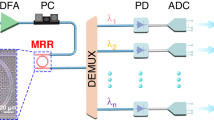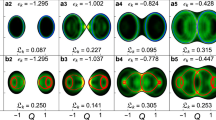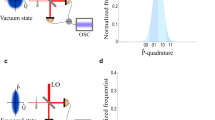Abstract
Random number generators in digital information systems make use of physical entropy sources such as electronic and photonic noise to add unpredictability to deterministically generated pseudo-random sequences1,2. However, there is a large gap between the generation rates achieved with existing physical sources and the high data rates of many computation and communication systems; this is a fundamental weakness of these systems. Here we show that good quality random bit sequences can be generated at very fast bit rates using physical chaos in semiconductor lasers. Streams of bits that pass standard statistical tests for randomness have been generated at rates of up to 1.7 Gbps by sampling the fluctuating optical output of two chaotic lasers. This rate is an order of magnitude faster than that of previously reported devices for physical random bit generators with verified randomness. This means that the performance of random number generators can be greatly improved by using chaotic laser devices as physical entropy sources.
This is a preview of subscription content, access via your institution
Access options
Subscribe to this journal
Receive 12 print issues and online access
$209.00 per year
only $17.42 per issue
Buy this article
- Purchase on Springer Link
- Instant access to full article PDF
Prices may be subject to local taxes which are calculated during checkout



Similar content being viewed by others
References
Eastlake, D., Schiller, J., & Crocker, S. Randomness requirements for security. Available at http://tools.ietf.org/html/rfc4086 RFC4086 2005.
Security requirements for cryptographic modules. Available at http://csrc.nist.gov/publications/fips/fips140-2/fips1402.pdf FIPS 140-2 (2001).
Metropolis, N., & Ulam, S. The Monte Carlo method. J. Am. Statist. Assoc. 44, 335–341 (1949).
Gisin, N., Robordy, G., Tittel, W., & Zbinden, H. Quantum cryptography. Rev. Modern Phys. 74, 145–195 (2002).
Marsaglia, G. DIEHARD: A battery of tests of randomness. Available at http://stat.fsu.edu/∼geo (1996).
Rukhin, A. et al. A statistical test suite for random and pseudorandom number generators for cryptographic applications. National Institute of Standards and Technology, Special Publication 800-22 (2001).
Kim, S. J., Umeno, K. & Hasegawa, A. Corrections of the NIST statistical test suite for randomness. arXiv:nlin.CD/0401040v1 (2004).
Galton, F. Dice for statistical experiments. Nature 42, 13–14 (1890).
Knuth, D. The Art of Computer Programming: Volume 2: Seminumerical Algorithms 3rd edn (Addison-Wesley Professional, 1996).
Kelsey, J. Entropy and Entropy Sources in X9.82 (NIST, 2004).
Schindler, W. & Killmann, W. Evaluation criteria for true (physical) random number generators used in cryptographic applications. CHES 2002, Lecture Notes in Computer Science 2523, 431–449 (2002).
Jun, B. & Kocher, P. The Intel random number generator. White paper prepared for Intel Corporation, Cryptography Research Inc. Available at http://www.cryptography.com/resources/whitepapers/IntelRNG.pdf. (1999).
Holman, W. T., Connelly, J. A. & Dowlatabadi, A. B. An integrated analog/digital random noise source. IEEE Trans. Circuits and Systems I 44, 521–528 (1997).
Dynes, J. F., Yuan, Z. L., Sharpe, A. W. & Shields, A. J. A high speed, post-processing free, quantum random number generator, arxiv/0807.4111v1 (July 2008).
Cortigiani, F., Petri, C., Rocchi, S. & Vignoli, V. Very high-speed true random noise generator. The 7th IEEE International Conference on Electronics, Circuits and Systems, 2000 (ICECS 2000) 1, 120–123 (2000).
Bucci, M., Germani, L., Luzzi, R., Trifiletti, A. & Varanouvo, M. A high-speed oscillator-based truly random number source for cryptographic applications on a Smart Card IC. IEEE Trans. Comput. 52, 403–409 (2003).
Tokunaga, C., Blaauw, D. & Mudge, T. True random number generator with a metastability-based quality control. IEEE J. Solid-State Circuits 43, 78–85 (2008).
Ornstein, D. S. Ergodic theory, randomness and ‘chaos’. Science 243, 182–187 (1989).
Wolfram, S. Random sequence generation by cellular automaton. Adv. Appl. Math. 7, 123–169 (1986).
Stojanovski, T. & Kocarev, L. Chaos-based random number generators-part I: analysis [cryptography]. IEEE Trans. Circ. Syst. I: Fund. Theory Appl. 48, 281–288 (2001).
Pappu, R., Recht, B., Taylor, J. & Gershenfeld, N. Physical one-way functions. Science 297, 2026–2030 (2002).
Gleeson, J. T. Truly random number generator based on turbulent electroconvection. Appl. Phys. Lett. 81, 1949–1951 (2002).
Callegari, S., Rovatti, R. & Setti, G. Embeddable ADC-based true random number generator for cryptographic applications using nonlinear signal processing and chaos. IEEE Trans. Signal Process. 53, 793–805 (2005).
VanWiggeren, G. D. & Roy, R. Communication with chaotic lasers. Science 279, 1198–1200 (1998).
Argyris, A. et al. Chaos-based communications at high bit rates using commercial fibre-optic links. Nature 438, 343–346 (2005).
Liu, J. M., Chen, H. F. & Tang, S. Synchronized chaotic optical communications at high bit rates. IEEE J. Quant. Electron. 38, 1184–1196 (2002).
Lang, R. & Kobayashi, K. External optical feedback effects on semiconductor injection laser properties. IEEE J. Quant. Electron. 16, 347–355 (1980).
Uchida, A., Liu, Y. & Davis, P. Characteristics of chaotic masking in synchronized semiconductor lasers. IEEE J. Quant. Electron. 39, 963–970 (2003).
Bracikowski, C., Fox, R. F. & Roy, R. Amplification of intrinsic noise in a chaotic multimode laser system. Phys. Rev. A 45, 403–408 (1992).
Uchida, A., Heil, T., Liu, Y., Davis, P. & Aida, T. High-frequency broad-band signal generation using a semiconductor laser with a chaotic optical injection. IEEE J. Quant. Electron. 39, 1462–1467 (2003).
Acknowledgements
The authors thank Y. Tonomura, N. Ueda, S. Makino, K. Nakazawa, M. Miyoshi and J. Muramatsu of NTT Communication Science Laboratories and S. Katagiri of Doshisha University for their support and encouragement. A.U. acknowledges support from NTT Corporation, Support Centre for Advanced Telecommunications Technology Research, and Grants-in-Aid for Scientific Research from the Japan Society for the Promotion of Science. We thank K. Umeno, S.-J. Kim and H. Terai for advice on the statistical evaluation of random numbers. We are grateful to I. Fischer, L. Larger, C. R. Mirasso and R. Roy for helpful discussions on laser chaos.
Author information
Authors and Affiliations
Corresponding author
Supplementary information
Supplementary Information
Supplementary Information (PDF 637 kb)
Supplementary Information
Supplementary Information (AVI 6802 kb)
Rights and permissions
About this article
Cite this article
Uchida, A., Amano, K., Inoue, M. et al. Fast physical random bit generation with chaotic semiconductor lasers. Nature Photon 2, 728–732 (2008). https://doi.org/10.1038/nphoton.2008.227
Received:
Accepted:
Published:
Issue Date:
DOI: https://doi.org/10.1038/nphoton.2008.227
This article is cited by
-
Efficient dynamic channel assignment through laser chaos: a multiuser parallel processing learning algorithm
Scientific Reports (2023)
-
Massive and parallel 10 Tbit/s physical random bit generation with chaotic microcomb
Frontiers of Optoelectronics (2023)
-
Optical quantum random number generators: a comparative study
Optical and Quantum Electronics (2023)
-
Image encryption using spatial nonlinear optics
eLight (2022)
-
Chaotic microlasers caused by internal mode interaction for random number generation
Light: Science & Applications (2022)



